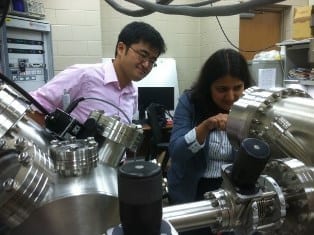Scientists Capture First Direct Proof of Hofstadter Butterfly Effect
This is a guest post from Zenaida Kotala, UCF Today.
A team of researchers from several universities – including UCF –has observed a rare quantum physics effect that produces a repeating butterfly-shaped energy spectrum in a magnetic field, confirming the longstanding prediction of the quantum fractal energy structure called Hofstadter’s butterfly.
This discovery by the team paves the way for engineering new types of extraordinary nanoscale materials that can be used to develop smaller, lighter and faster electronics, including sensors, cell phones, tablets and laptops.
First predicted by American physicist Douglas Hofstadter in 1976, the butterfly pattern emerges when electrons are confined to a two-dimensional plane and subjected to both a periodic potential energy and a strong magnetic field. The Hofstadter butterfly is a fractal pattern—meaning that it contains shapes that repeat on smaller and smaller size scales. Fractals are common in systems such as fluid mechanics, but rare in the quantum mechanical world. The Hofstadter butterfly is one of the first quantum fractals theoretically discovered in physics but, until now, there has been no direct experimental proof of this spectrum.
Columbia University led the study and also involved scientists from the City University of New York, Tohoku University and the National Institute for Materials Science in Japan. Columbia prepared the sample and the UCF team measured the regular recurrence of the high-fidelity periodic pattern, engineered by inducing nanoscale ripples on graphene, a carbon material. The measured recurrence served as the essential proof that the measured spectrum was indeed the Hofstadter butterfly. The image that captured the evidence was taken in UCF Assistant Professor Masa Ishigami’s laboratory.
Read the full piece here.

